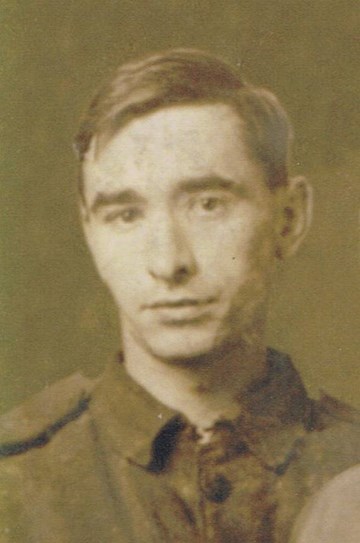Ernest Brooks and the photograph of The 'Forty Thieves'
- Home
- World War I Articles
- Ernest Brooks and the photograph of The 'Forty Thieves'
With recent developments in technology, the colourisation of monochrome images from the Great War has come on in leaps and bounds. The obvious example is the film 'They Shall Not Grow Old' by Peter Jackson. Others have been doing similar work but obviously on a much smaller scale. One example of this is an excellent image of the famous photograph taken in 1916 of a group of men who had just taken part in a trench raid.

The colourisation here (by Royston Leonard) is shown on the Facebook group called 'WW1 Colourised Photos' and has used, as its basis, the black and white photograph taken by Ernest Brooks which is part of the IWM's collection (number Q510).
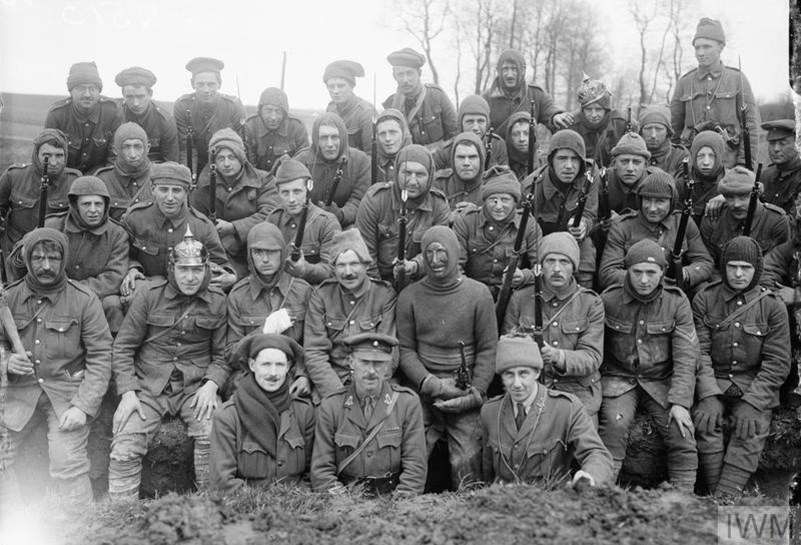
Examining the two photographs it is apparent that the 'old bill' character on the left of the group is one of a number of men who have been omitted from the colourised image. This led me to not only re-examine the photo but also dig deeper into the story here.
Ernest Brooks
The starting point for the story of this photograph is Ernest Brooks. He was the first British official war photographer assigned to the Western Front. Previously, Brooks had served as a photographer (working under Admiralty orders) at Gallipoli, but in March 1916 he was transferred to the War Office, given a second-lieutenant's rank and sent to Flanders.
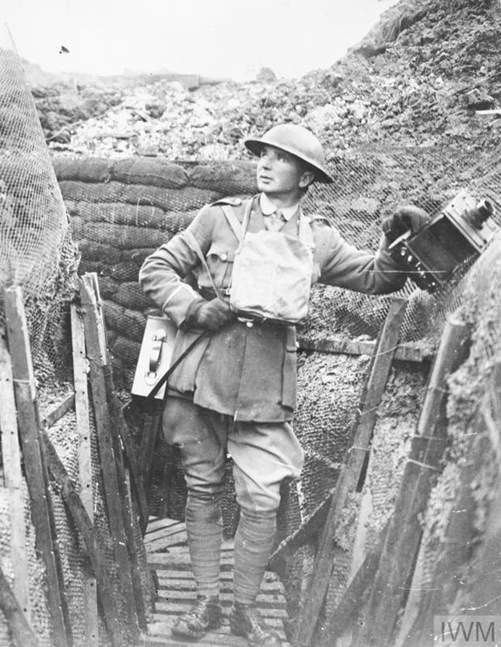
Above: Ernest Brooks, the first British official photographer to be appointed, seen in a trench on the Western Front. He is carrying a Goerz Anschutz plate camera. Brooks served as a photographer on the Western Front from March to 1916 to early 1919. IWM, Q 24087
Brooks commenced work, as far as can be ascertained, on 2 March 1916 with what he must have thought was a very dull assignment after Gallipoli. This first job was taking photographs of horses undergoing skin disease treatment at the Number 10 Veterinary Hospital at Neufchatel, near Etaples. (These first nine photographs are numbered by the IWM Q550 to Q558). The following day, he was still photographing horses undergoing treatment, this time at the Number 5 Veterinary Hospital at Abbeville, the results of this work are IWM Q559 to Q562. However there exists another image, given a 'Q' number out of sequence (Q506) which is clearly part of the 3 March visit. Not only is the 'Q' number out of sequence but is misdated as being taken on 3 April.
Whilst it may of course be the case that he returned to the Veterinary Hospital, this seems very unlikely, and what we clearly have here is a mis-sequencing and mis-dating of one of Brooks' early photographs. From this - and other examples it is apparent that not only the sequencing but also the dates provided in the captions of these photographs may not be wholly accurate.
Contacting the Imperial War Museum's Alan Wakefield (The Head of First World War & Early 20th Century Conflict), brought about an explanation for some of the issues here. Alan said the following:
I believe [the Q series numbering] was instituted by IWM soon after it took over the archive of official wartime photos from the Ministry of Information in 1919. Before that, each official photographer had an individual letter prefix. The early Brooks photos were prefixed C. The IWM holds two handwritten ledgers that cross reference the Q numbers to the original reference numbers. With regard to the C reference numbers, I believe these were assigned by the MOI after the negatives were received from France, where they were censored by GHQ’s Intelligence Department. The negatives were censored again on reaching the Ministry of Information before being numbered and made available to the press.
With regard to certain photographs being out of chronological sequence, this is possibly due to the reference numbers assigned by the Ministry of Information on receipt of a batch of negatives from France, which could have covered a photographer’s output over a number of days / weeks. This may have led to some re-ordering within the sequence of negatives possibly to use photographs out of chronological context to fill gaps in possible ‘photo stories’.
There is of course only a limited amount of excitement to be generated from photographs of horse skin disease treatment, so it was probably with some relief that Brooks received his next assignment which seems to have been with the 1st Canadian Division. The first of these images is dated 9 March 1916 when he took the photograph shown below. This was given the reference number Q441 by the Imperial War Museum.

Above: Lieutenant Kent of the 10th Battalion, Canadian Expeditionary Force, being decorated by Lieutenant General Edwin Alderson with the Military Cross. Near Locre, 9th March 1916. (IWM Q441)
A series of photographs followed whilst he was with the Canadians. These are all vaguely dated 'March 1916', with only two others of this 'Canadian set' given a specific date (of 29 March 1916). Some of these are captioned as being taken in Ploegsteert Wood such as Q444. Other photographs by Brooks from this month are of the Royal Horse Artillery, including some of an anti-aircraft section which place him in Armentieres.
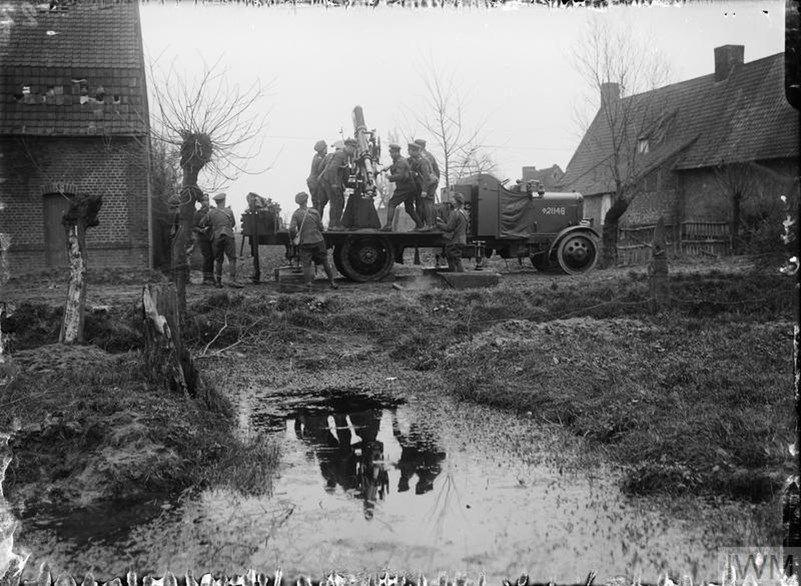
Above: Probably men of the Royal Horse Artillery with a 13 pounder 9 cwt anti-aircraft gun on Mark III Motor Lorry Mounting, on the outskirts of Armentieres. March 1916. IWM Q462
Brooks also covered the arrival of General Cadorna, the Italian c-in-c who arrived in Calais in March. These are numbered Q478 to Q485. This was probably perceived as another 'dull' assignment, but nevertheless important to show allied cooperation.
On 27 March, Brooks took a series of ten photographs (numbered Q491 to Q500) of men mainly from the Northumberland Fusiliers (3rd Division) following the attack of the 1st and 4th battalions at St Eloi. There exists a few seconds of film footage - shot by Geoffrey Malins - which shows Ernest Brooks at work setting up and posing the men for his photographs. This fascinating footage is available via this link IWM Q215. (The footage of Brooks setting up his photographs by talking to the troops is at the end of this clip, between the 9 minute to 10 minute mark.) Below is a screenshot from this IWM footage, showing Brooks setting up the photographs (shown below) he was about to take.


Above: Actions of St. Eloi Craters. Troops of the Northumberland Fusiliers, 3rd Division, wearing German helmets and gas masks captured at St. Eloi, 27th March 1916. IWM Q491

Above, IWM Q493 - this has the same caption as Q491
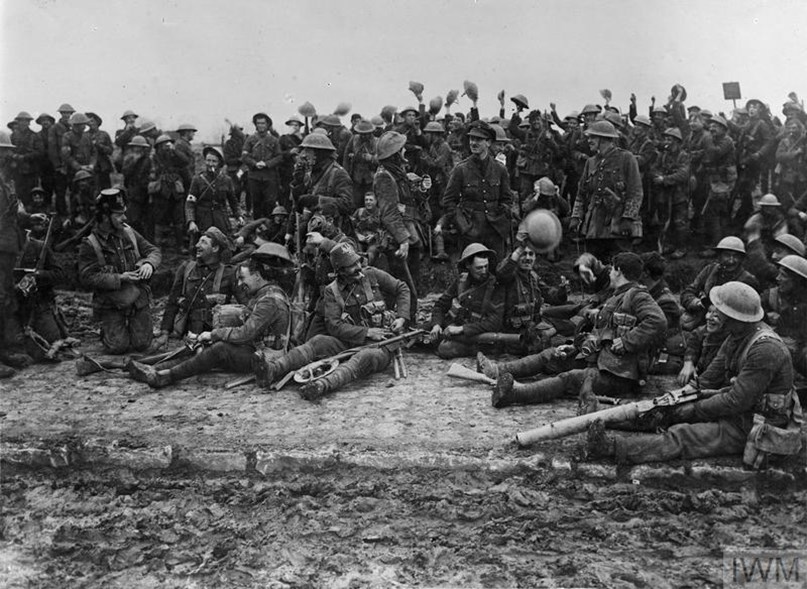
Above IWM Q495 which again has the same IWM caption. Brooks obviously took at the same time as the film footage by Malins.
Photographs (Q502 and Q503) dated 31 March exist showing he visited Ypres to photograph "the interior of the church in the square". Other images (vaguely dated 'April 1916') may be part of this visit or from a subsequent visit to Ypres, these include Q466, Q469 and Q473 with a number of others from this time, but out of sequence.
April - front line
His next major assignment was with the 55th (West Lancashire) Division. Many battalions of the division had arrived in France as early as November 1914 in order to reinforce the BEF, and it was not until January 1916 the units were brought back together as a division and re-formed under Maj-Gen Sir Hugh Jeudwine. They went into the line in mid February for the first time as a division in a supposedly quiet sector at Wailly, south of Arras. It is not clear why Brooks was asked to photograph this division, nor is it clear if the senior officers welcomed his presence; on the balance of probabilities, perhaps he was 'tolerated' at best. It is likely, however, that the troops were delighted to be photographed.
The photographs taken at this time are once again seemingly incomplete in terms of what the IWM hold, as there are a few gaps in the Q series sequencing. For instance Q514 and Q515 do not exist.
Alan Wakefield again:
" ...it appears, my thinking regarding the GHQ Censor removing some photographs was correct. It is interesting that the London office gave these missing photographs a number – perhaps Brooks had reported back that he’d taken a specific number of photographs and the records were drawn up in advance of the arrival of the negatives.
Chronologically, the first of the photograph from this assignment seems to be dated 9 April where we have Q522 which is again out of order and the reference number places it in the middle of the sequence of photographs taken on this assignment. This photograph is one illustrating damage to the church at Bretencourt but is not likely to make anyone's list of the most interesting images to come out of the war!
Following the so-called '9 April' photograph there is a gap of a few days, then what seems to be 23 images taken between 14 and 18 April which are referenced Q508 to Q535. These photographs are clearly taken in 'groups' (this supporting Alan Wakefield's assertion about the photographs being dealt with in batches) and some are almost identical. For example Q508, Q509, Q528 and the undated Q535 are near identical. At least the first three of these were taken on 14 April and show the bombardment of German trenches at Blaireville Wood. It is possible that the British bombardment brought about German retaliation, as seen in Q541.
Also on the 14th April we have Q511 which is of a soldier dressed as a woman (the caption tells us it's a member of the divisional concert party).
Brooks seemingly took no photographs on the 15th April (or at least none that passed the censors), but was busy on the 16th. It is impossible to work out the sequence in which he took the photos on the 16th, but we have one, Q512 , showing everyday (non combat) routine of the regimental barber of the King's Liverpool Regiment. Q513 shows a German shell bursting in Wailly, the bridge in the foreground features again in Q532; the caption, mentioning a shell bursting, seems to be inaccurate: where is the shell burst? (The water course here, if the location on the caption is accurate, will be a stream called the 'Le Crinchon'.) At some stage in the day, he seems to have visited the front line trench, because we see in Q534 a sentry using a periscope. Perhaps whilst in the front line he was lucky enough to be able to capture on a photograph (Q531) the last moments of a 'toffee apple' trench mortar falling on the German trenches. This was quite an achievement for the basic equipment available compared to today's photographic technology.
Visiting 'a wood near Blairville wood' (sic) we assume (in Q530) he captured German incoming artillery fire again. His visit to Bretencourt Chateau grounds (Q529) enabled him to take a photograph of the HQ of the 165 infantry brigade. The caption names the brigade commander, Brig-Gen Duncan - is he possibly one of the officers in this photograph?
Four photographs are very significant for the purpose of what was to follow, being Q524, Q525, Q526 and Q527. These are captioned as being of men of the King's Liverpool Regiment, 55th Division, moving along a communication trench and the last of these supposedly 'practising for an attack' near Blaireville. The question arises whether this caption is correct and this was indeed the practice for the trench raid. It will be recalled that he paid a visit to the HQ of 165 infantry brigade, which comprised 1/5th, 1/6th, 1/7th and 1/9th battalions of the Liverpool Regiment; however these battalions didn't take part in the raid that was to follow. Therefore it is likely these photos are of one of these battalions rather than the 1/8th battalion (which was part of a different infantry brigade: number 164).
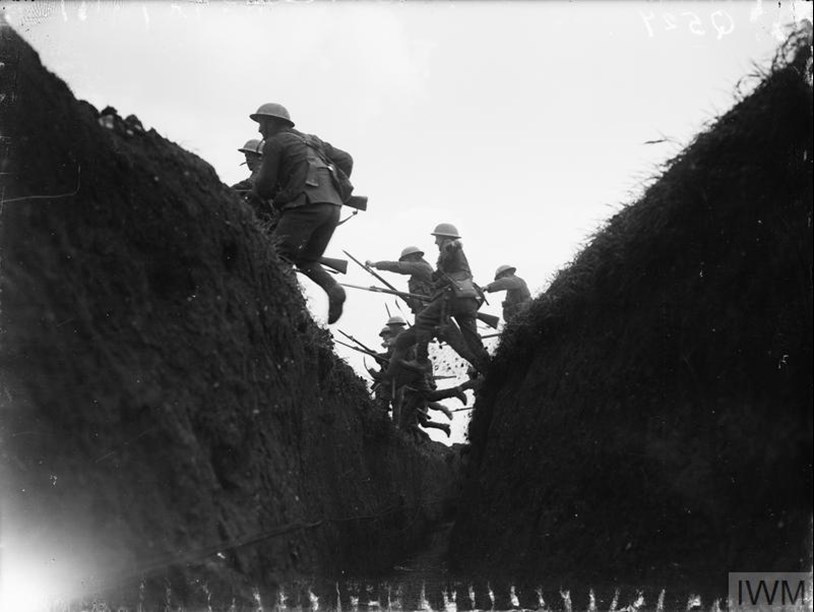
Q527
The final photograph definitely taken (according to the captions) on the 16th April is Q533 of an anti-aircraft gun in action.
It is possible, looking at the sequence of images that Q517 (undated) of a French civilian serving coffee to soldiers may be taken that same evening. Another undated photo is Q521 which shows cheerful soldiers posing in a damaged house in Wailly.
On the 17th he took just three photographs being Q518, Q519 and Q520. These are of the Loyal North Lancs (either the 1/4th battalion, or the 1/5th battalion) parading for the trenches.
From this sequence of photos, it is obvious that Brooks was with the 55th Division for a few days but was he told about the planned trench raid? In view of the likely level of secrecy, it is possible he was not told, but evidently was on hand to take his famous Q510 (which is numbered out of sequence with the others in the series) and is dated 18th April, being the morning after the raid.
Unusually, the caption names the specific battalion being photographed, being the 1/8th Liverpool Regiment. The question arises as to why this battalion was specifically named, given the obvious censorship that took part. Upon reflection, it is likely that this is in fact a post-war caption (possibly inserted by the IWM) which is supported by a reference to 'the divisional history'; this would seem to be the book, published in 1919, entitled “The story of the 55th (West Lancashire) Division” by the Rev. J. O. Coop. (In virtually all other cases, captions give the regiment but not the battalions being photographed.)
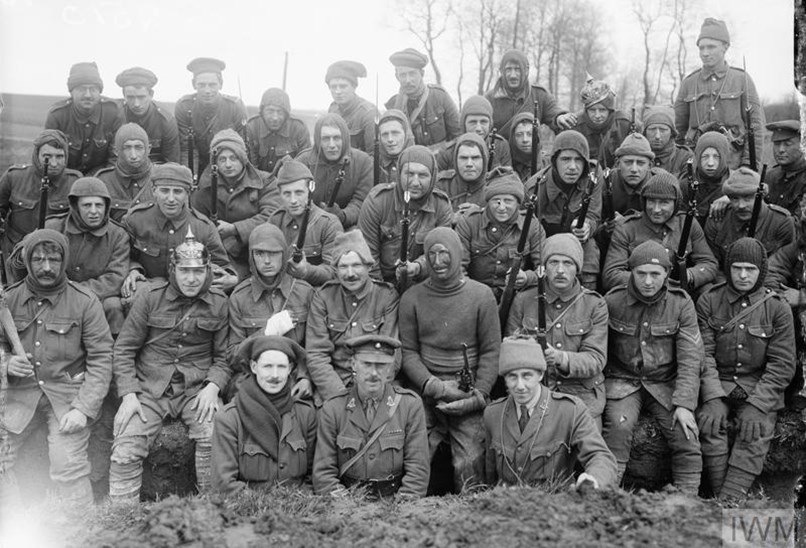
Above: the famous IWM Q510, the full caption of which is "A raiding party of the 1/8th (Irish) King's Liverpool Regiment, 55th Division, at Wailly, France. Photograph taken the morning after a night raid during the 17/18th April 1916."
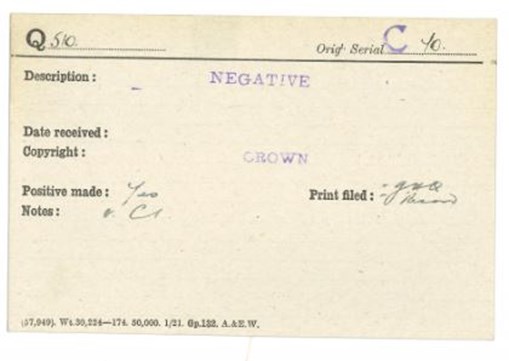

Above IWM card index showing the full caption on the reverse. Surely this is a post war addition?
The only photograph of this assignment in the Wailly area definitely taken after the famous 'Q510' seems to be Q516 which is of a French heavy gun. This is dated 19 April.
Forty Thieves
Brooks' photo (now Q510) is well known. But who are the men? Some of their names are known from the awards handed out and detailed in the battalion's war diary. But does the photograph show all of the men who took part?
Whilst the raiders (from the 1/8th Battalion of the Liverpool Regiment) became known as 'the Forty Thieves' the actual number of men taking part, and subsequently being photographed, is worth investigation.
According to a report on the battalion's raid which is in the war diary of the infantry brigade, the 'raiding party' comprised of 3 officers and 27 other ranks, with the remainder of the party (16 other ranks) covering them from outside the wire.
The battalion's war diary talks of 2 officers and 2 other ranks going out as a wire cutting party (the wire had been largely cut the previous night) and when this was completed, these 4 individuals were joined by another officer and 23 more men. As can be seen, the numbers here don't quite add up. If the storming party did in fact comprise three officers and 25 men (being the men on the wire cutting duties plus those brought up afterwards) PLUS the 16 other ranks who were the covering party, we have a total of 44 officers and men taking part.
The raiders all returned apart from one officer who was killed in the raid.
A close examination of the photograph shows 41 individuals (including one man on the right of the middle row who only managed to get his arm into the photo) but from research undertaken by Simon Jones, two of the officers shown in the photograph didn't take part in the raid. This suggests that perhaps four of the raiders did not make it onto the photograph. Perhaps they were cropped out similar to individual 38?
Who are the men on the photograph? We can only put five faces to names here, but we do know a lot about the officer who failed to return.
Victoria Cross
2/Lt Edward Felix Baxter was one of the three officers participating in the raid. He is not photographed because he lost his life during the raid. He was awarded the VC and is now buried at Fillievres British Cemetery.
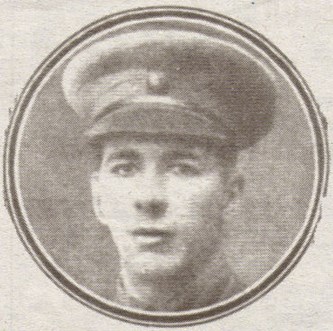
Above: 2/Lt Edward Baxter, VC

Above: Baxter's headstone. Image © Geerhard Joos
Citation
An extract from "The London Gazette," dated 26th Sept., 1916, records the following:
"For most conspicuous bravery. Prior to a raid on the hostile line he was engaged during two nights in cutting wire close to the enemy's trenches. The enemy could be heard on the other side of the parapet. Second Lieutenant Baxter, while assisting in the wire cutting, held a bomb in his hand with the pin withdrawn ready to throw. On one occasion the bomb slipped and fell to the ground, but he instantly picked it up, unscrewed the base plug, and took out the detonator, which he smothered in the ground, thereby preventing the alarm being given, and undoubtedly saving many casualties. Later, he led the left storming party with the greatest gallantry, and was the first man into the trench shooting the sentry with his revolver. He then assisted to bomb dug-outs, and finally climbed out of the trench and assisted the last man over the parapet. After this he was not seen again, though search parties went out at once to look for him. There seems no doubt that he lost his life in his great devotion to duty."
The other men
A great deal of work has been done by a number of people trying to work out the names of some of the men in this photograph. Simon Jones who was previously the curator of the King's Liverpool museum has done probably more than anyone. Simon has established is that there are four officers shown in the photograph (three in the front row and one- in a balaclava - in the second row between two of the officers). Two of these took part in the raid, two did not.
From IWM Q510, Simon has identified these officers as follows:
Front left (with floppy headgear) is Captain James Harold Mahon. He took part in the raid. Mahon was born in Liverpool, and a resident in Wallasey, aged 27. Prior to the war he worked as a clerk for the Mersey Docks & Harbour Board and had served nearly six years in the ranks of the Liverpool Rifles.
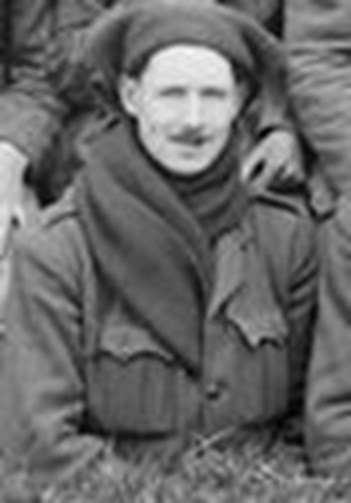
Mahon had been with the Battalion ever since it had been in France. Simon doesn't know if he regarded himself as Irish, his religion was actually Wesleyan.
Front Centre (with peaked cap) is Lieutenant Colonel Edward Arthur Fagan, aged 44, was an Indian Army officer. He did not participate in the raid.

He sits here with the raiding party, his medal ribbons are not those that are normally seen. They are the Queen’s and King’s South Africa medals, and from the Tirah campaign of 1897-98 plus the Tibet Expedition of 1907.
Front right (rolled up balaclava) is Captain George Stanley Brighten.

Brighten was the battalion adjutant and whilst not one of the raiders, probably undertook a lot of the planning of the raid, so felt entitled to join the photograph. He seems to be holding what may be a mills bomb in his left hand, but the fact that he and Fagan had regimental badges on their collars gives the game away that they did not participate in the raid.
The officer holding the revolver (with camouflage on his face) between Fagan and Brighten is Lt Paul Osborne Limrick. He was the battalion's intelligence officer (he was to be killed on 12 September 1916)
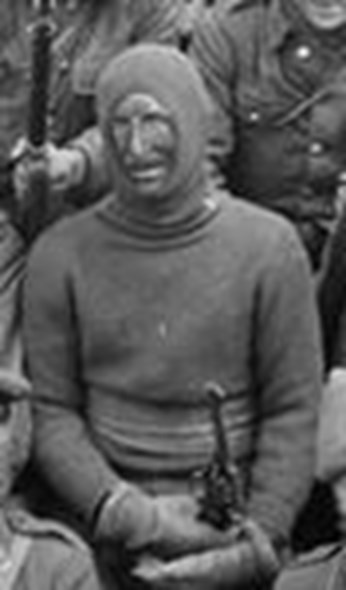
Only one other individual has been able to be identified from the group and this is the previously mentioned 'old bill' lookalike. He is 3541 Pte James Condon.
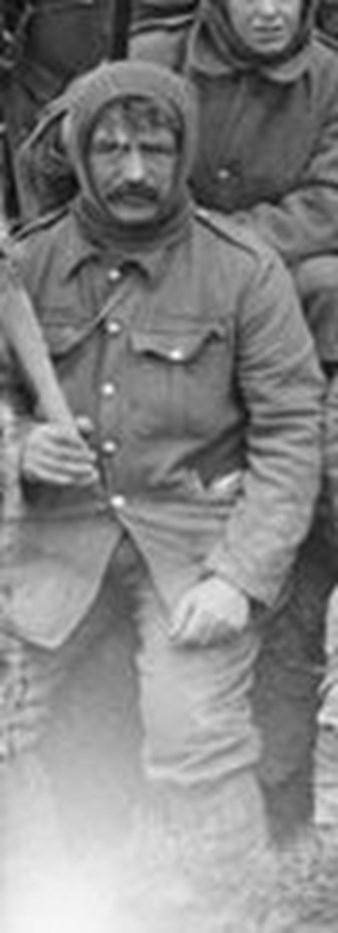

James Condon was born in County Cork and lived in Chester. He had been discharged from the Cheshire Regiment Territorials before the war as over age. He joined the Liverpool Irish almost certainly by lying about his age: at the time of this photograph he was aged 46. Condon is holding a knobkerrie. He was killed in September 1916, aged 44 according to the CWGC. The CWGC having a mis-recorded age strongly suggests lied about his age when re-joined the Army. Below is the pension record card for James Condon.
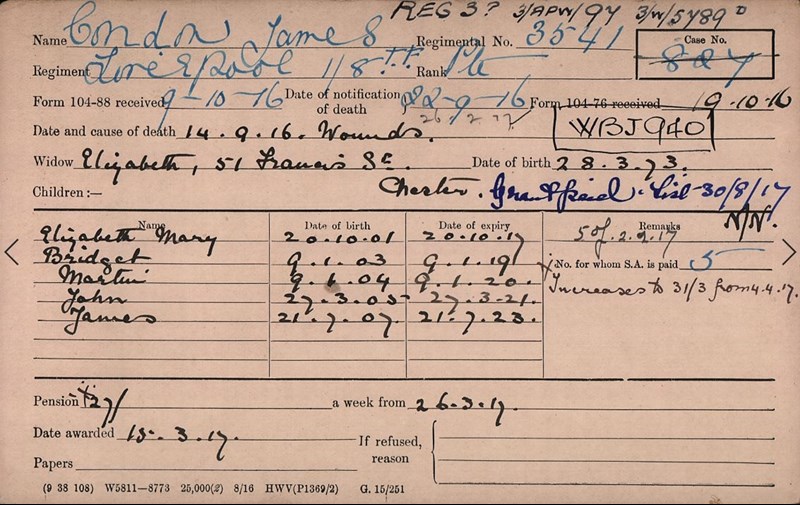
James is buried at La Neuville British Cemetery, approximately halfway between Albert and Amiens.
The war diary lists the medals awarded to those taking part in the raid. Whilst there is not space in this article to name or detail the men, perhaps just three of these men can be used as examples of the raiders from the Liverpool Irish, and what can be found using - among other sources - The Western Front Association's Pension Record Cards.
Joseph Sloey
It is not possible to identify Joseph in the raiders photo. Below is a photo of him taken before the war.

Below is his Pension Record Card.
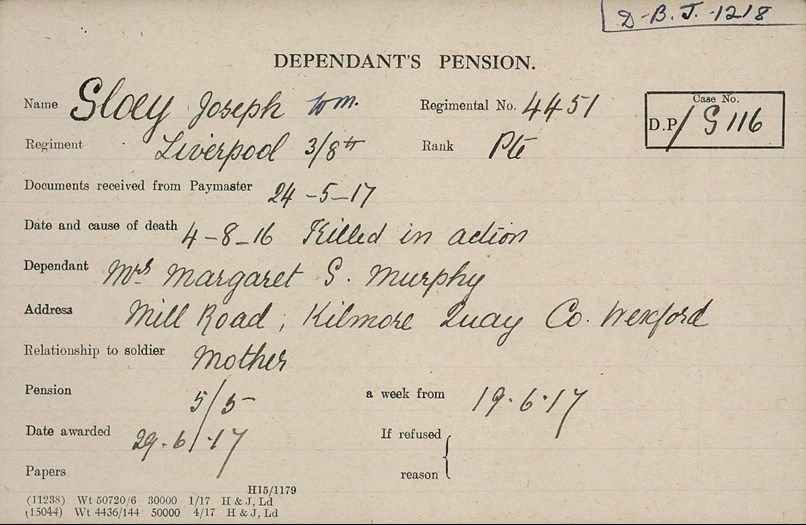
Joseph was killed on 4 August 1916, and is buried Corbie Communal Cemetery extension.
Francis Brophy MM
Francis was killed in November 1916 buried at Lijssthenthoek Military Cemetery
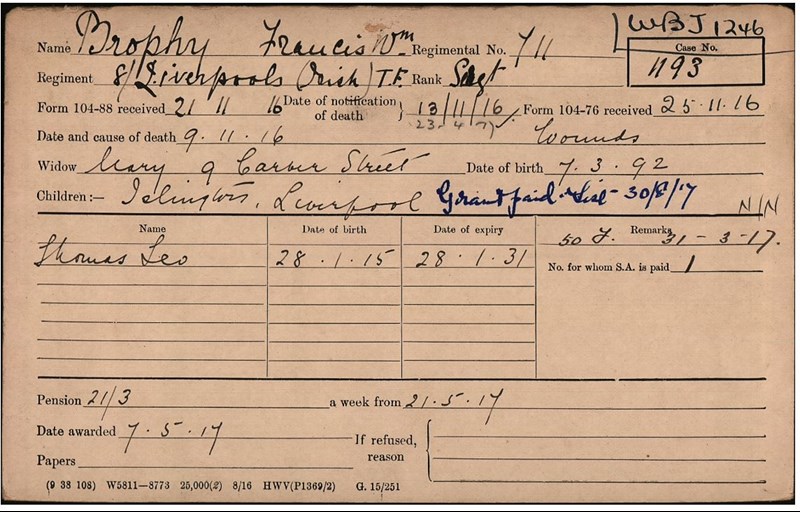
Percy Fussell
Percy Fussell was one of the men awarded a Military Medal as a result of the raid. Taken prisoner at Guillemont in August 1916. He was discharged in April 1919 and the following July he re-enlisted in the Devonshire Regiment. He died of appendicitis in India on the 25th October 1919. In this instance, he has been identified on the group photo and details of this can be found here:
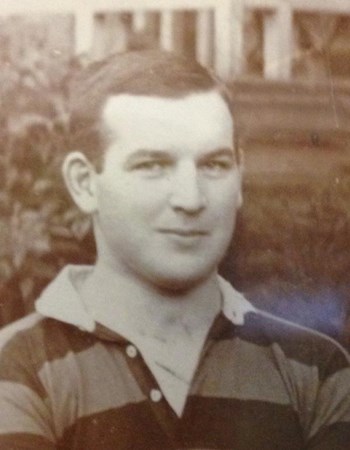
Percy is buried in India, at Jutogh New Cemetery. near Shimla.
Simon Jones summarises an interesting footnote to the men who took part in the raid as follows:
Of the sixteen raiders identified, half were killed during the Battle of the Somme. The remainder survived the war. What I believe to have been the last surviving member of the raiding party was mentioned in the Liverpool Merseymart, a free newspaper, in March 1995. This was a report of the funeral of Billy Brownbill, who had died aged 104. He had been the country's oldest surviving gunner but his unit had originally been the Liverpool Irish. There were few details given of his military service except that he had once been a member of a raiding party known as the forty thieves.
Ernest Brooks again
Brooks went on to take hundreds of photographs during the war, many of the images are now iconic.
It is beyond the scope of this article to look at the rest of Brooks' work, but perhaps just one image may be used to illustrate what he went on to produce.
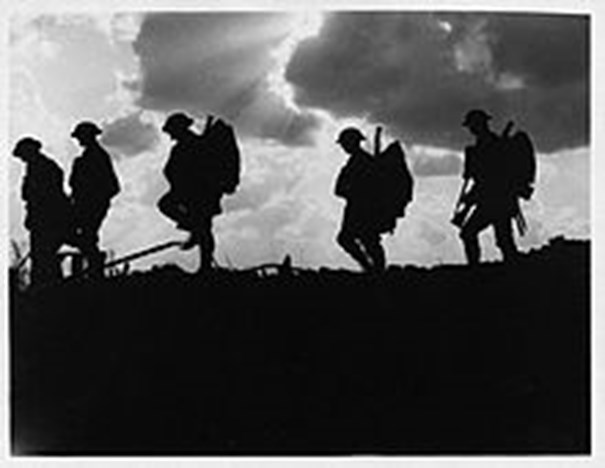
Above: IWM Q2978 'Men of the 8th Battalion, East Yorkshire Regiment going up to the line near Frezenberg during the Third Battle of Ypres, 5 October 1917'
Further reading
The story of how 2nd Lieut. Edward Felix Baxter was awarded the VC
Acknowledgements
My thanks to Simon Jones and Alan Wakefield for making this article possible.
Simon Jones is a freelance military historian. He gives a number of talks to WFA branches, including one on 'The Forty Thieves'. If you wish to hear Simon give this presentation, please contact your local branch chairman. Here's a link to Simon's blog SIMON JONES
Alan Wakefield is now Head of the First World War & Early 20th Century curatorial team. He specialises in the Salonika campaign and also gives numerous talks. He can also be booked as a speaker by WFA branches. Alan is the chairman of the Salonika Campaign Society.
Article by David Tattersfield, Vice-Chairman, The Western Front Association






